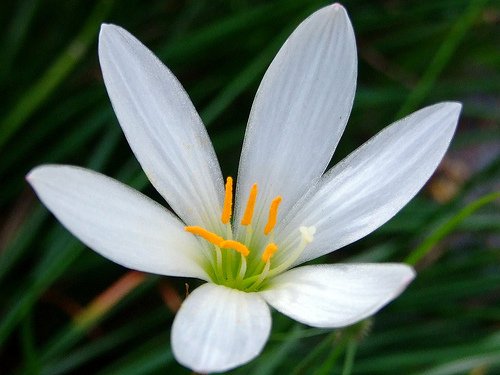Autumn Crocus
Zephyranthes candida
This tough little bulb flowers in profusion after rain – hence its sometime alias, the storm lily. It has shiny evergreen foliage and the flowers are white and open, like fragile crocuses. zephyranthes will grow in most regions in sun or semi-shade. Protect it from the hot sun in warm climates. It is not fussy about soil, even coping with poorly drained clay soils. It’s a little gem for containers (where a watering can may imitate rain, giving plenty of flowers) and it makes a delightful border in both formal and informal designs.

These 'storm lilies' (Zephyranthes candida, ht 15-25cm) come from Argentina and have grassy foliage and flowers rather like a crocus, and are easily grown in Sydney. In fact they are the only crocus-looking bulb most of us can grow, as generally Sydney's climate is too mild for real crocuses, which belong to the Iridaceae family of plants. Zephyranthes candida comes from the Amaryllidaceae family of bulbs, which on the whole do very well in our region.

They have papery white or (more rarely) pastel pink flowers, with thin evergreen foliage. They seem to come into bloom after rain has fallen, hence their common name, and several flushes of flowers can be expected if there a few periods of rain in late summer and autumn. They may even flower earlier in summer if there is a lot of rain. They form thick clumps and can survive in quite dry positions, such as at the base of a hedge, but will also cope with more moist positions. It is best if they dry out in late summer as the time approaches for their flowering period. They can be fertilised whenever you are doing the rest of your garden. They can be grown in a pot and do best with plenty of sun. Watch out for snails and slugs, which can wreck the flowers.

It goes by the various common names of zephyranthes, rain lily, autumn crocus or windflower. I had a friend who called it birthday flower as it always bloomed on her birthday. It has small, white, crocus-like flowers set amid a mass of dark green tubular leaves. It grows about 20cm high and flowers after rain (hence the name rain lily) in late summer and has flushes of flowers during autumn (which is why it is also known as autumn crocus).

It grows from a bulb or can be bought in pots at the nursery. Zephyranthes (which suggests the wind and the other common name of windflower) does best in a sunny spot in well-drained soil and can be grown as a border plant or in clumps to give interest to the garden in summer and autumn. It naturalises readily and, in parts of Queensland, it is even considered a bit of a weed.

src
